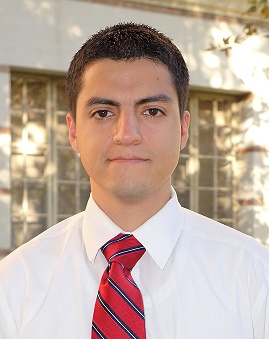News | USC Master of Planning student Arnold Valdez coauthors published research, Transferability Study of the Large Zone Economic Module (LZEM) of the SE3M Model of Land Use and Transportation
Stop the VideoNews

METRANS UTC
USC Master of Planning student Arnold Valdez coauthors published research, Transferability Study of the Large Zone Economic Module (LZEM) of the SE3M Model of Land Use and Transportation
Tuesday, March 10, 2015

USC Master of Planning student Arnold Valdez was recently published in the Journal of Applied Geography. Valdez worked on this paper as an undergraduate and as coauthor was responsible for the coding, data gathering/processing, visual representation, and part of the writing of the final manuscript. The abstract is below, and the complete article may be accessed at http://www.sciencedirect.com/science/article/pii/S0143622815000259
Link may require library access or subscription.
Arnold Valdez is a first year Master of Planning student at the USC Price School of Public Policy. His academic interests are in transportation, urban economics, and spatial interactions and relationships at a regional scale. He expects to complete his MPL in spring 2016, and then plans to pursue a PhD and a career in transportation research. Mr. Valdez currently resides in Los Angeles with his wife, Laura.
Abstract
Models of urban land use are often used in the policy analysis process to forecast long-range impacts of various land use policies or urban infrastructure projects. For models that have been deemed suitable for multiple implementations, a critical, initial test of the model framework is to examine the model's transferability to other geographies. The purpose of this paper is to present a transferability study of the Large Zone Economic Module (LZEM) of the SE3M model of land use and transportation. The SE3M was initially implemented in the US territory of Guam. The islands of Puerto Rico and Oahu were selected as case studies for this model, transferability evaluation. LZEM is implemented with three base years (2000, 2002 and 2007) for these case studies and then validated to 2010 as horizon year for which validation data was available in the Puerto Rico and Oahu implementations. This paper presents evidence that LZEM is reasonably accurate when applied to other geographic regions and that if specific economic parameters are identified, the entire regional economy and the associated population and employment distribution can be spatially modeled within the LZEM framework.
News Archive
- December (1)
- November (6)
- October (4)
- September (2)
- August (3)
- July (4)
- June (3)
- May (7)
- April (8)
- March (11)
- February (8)
- January (7)
- December (7)
- November (8)
- October (11)
- September (11)
- August (4)
- July (10)
- June (9)
- May (2)
- April (12)
- March (8)
- February (7)
- January (11)
- December (11)
- November (5)
- October (16)
- September (7)
- August (5)
- July (13)
- June (5)
- May (5)
- April (7)
- March (5)
- February (3)
- January (4)
- December (4)
- November (5)
- October (5)
- September (4)
- August (4)
- July (6)
- June (8)
- May (4)
- April (6)
- March (6)
- February (7)
- January (7)
- December (8)
- November (8)
- October (8)
- September (15)
- August (5)
- July (6)
- June (7)
- May (5)
- April (8)
- March (7)
- February (10)
- January (12)















